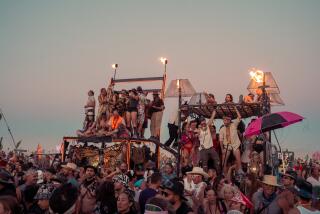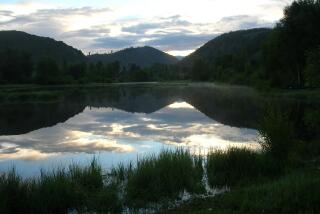Strength in Adversity
- Share via
MARTIN'S COVE, Wyo. — This is a place of great pain--and greater triumph.
Here the members of the Martin and Willie handcart companies lay themselves down to die in the freezing winter weather they had hoped would hold back until they reached Salt Lake Valley.
Because of their overwhelming desire to reunite with their friends and to avoid another winter in harsh Winter Quarters, they left despite warnings from the council of church and secular leaders. They had too few provisions and too many of the very young and very old. Of the 550 members of the Martin company, more than 130 died, and the Willie company fared no better.
My cousin Sarah Robinson’s great-great grandmother, Elizabeth Hannah Parks, was one of the survivors from the Martin company.
“She never could talk about it for the rest of her life,” Sarah said. “She was 26 when it happened, and she lived a long time, but in all those years she never could talk about what happened.”
Today being a rest day for our modern-day wagon train, most of the company went to visit Martin’s Cove, a sheltered crease in the rock hills that rise from the prairie desert, where the pioneers tried to escape the elements. Sarah and I stayed behind to help Jerry and Jan Pierce, the check-in coordinators, register new people.
Jerry had just returned from visiting Martin’s Cove and was still stirred by the memorial there. His great-great-grandfather, Ephraim Hanks, was among those Brigham Young sent to rescue the trapped companies and was the first to arrive at their camp.
“That’s when it really kind of hit home to me about my great-great-grandfather,” Jerry said. “Here his name is on the list saying ‘rescuers sent out to rescue the handcart company.’ Then over on another wall was a whole big thing just about him. And there is a painting of him finding those people.
“My mother has told me the story all my life, and I kind of blew it off. She’s got that picture of him coming over the hill and the line of handcarts seeing him, and that’s been hanging on the wall all my life. It just didn’t mean anything until I went there.”
In horrific cold, freezing flesh falling from their legs, the companies had resigned themselves to death. Hanks later described the scene:
“The sight that met my gaze as I entered their camp can never be erased from my memory. The starved forms and haggard countenances of the poor sufferers as they moved about slowly, shivering with cold, to prepare their scanty evening meal, was enough to touch the stoutest heart. When they saw me coming, they hailed me with joy inexpressible, and when they further beheld the supply of fresh meat I brought into their camp, their gratitude knew no bounds.”
The rest of the rescue party reached Martin’s Cove, but the misery was not over. There was still the Sweetwater River between the rescuers and the survivors, and it seemed unlikely that the barely alive survivors could survive the freezing water.
Four young men--David P. Kimball, George W. Grant, C. Allen Huntington and Steven Taylor--volunteered to carry the company across on their backs. They succeeded, but the effort cost three of the rescuers their lives. Only Taylor survived.
Sarah and I arrived at Martin’s Cove on a beautiful, clear night with a moon so bright we could read the commemorative plaques along the trail. The moonlight made the shadows seem all the darker, casting the scene in a ghostly black and white as we walked the five-mile loop from the visitor’s center to the cove.
The Sweetwater River, such a threat to survivors and rescuers alike, was running peacefully at the side of the trail.
We talked about the rescuers, risking death to save people they didn’t even know. They were not martyrs; we’ve had plenty of those, many making sacrifices that were more wasteful than effective.
The rescuers were like the many people today who give their strength and more when they find a cause that means more to them than even self-preservation.
It was a beautiful and thought-provoking night at Martin’s Cove. Nothing magical happened--no apparitions of doomed pioneers or heroic rescuers. Only thoughts about sacrifice--what it’s worth, what it can mean.
* Kathy Stickel, 27, of Huntington Beach is filing periodic reports from the Mormon Trail Wagon Train, which is retracing the 1,000-mile route of the Mormon migration from Iowa to Utah 150 years ago.
More to Read
Sign up for Essential California
The most important California stories and recommendations in your inbox every morning.
You may occasionally receive promotional content from the Los Angeles Times.













